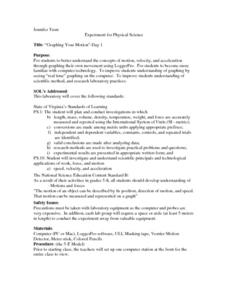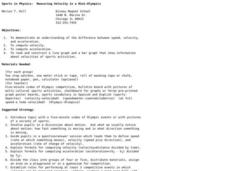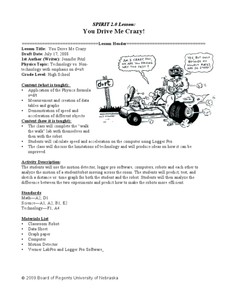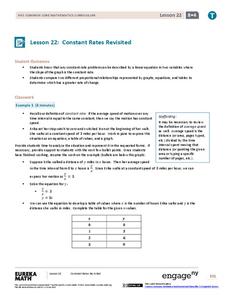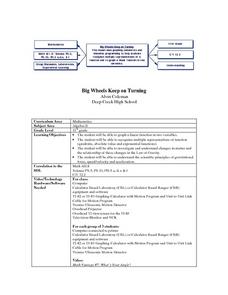NASA
Measuring Dark Energy
You're only 10 minutes late? Do you know how much the universe has expanded in those 10 minutes? Scholars graph supernovae based on their redshift and see if the results verify Hubble's Law. If it does confirm it, the universe is...
Curated OER
Graphing Your Motion-Day 1
Ninth graders explore the concepts of motion, velocity and acceleration through graphing their own movement using LoggerPro. They become more familiar with the computer technology. Students explore graphing in real time and graph on...
Curated OER
Intro to 1D Kinematics with Physlets
Twelfth graders examine illustrations and animations on a Physlets CD in which they must describe motion, analyze graphs, and calculate initial velocity. The Physlet assists in providing active class participation in discussion.
Curated OER
Sports in Physics: Measuring Velocity in a Mini-Olympics
Eighth graders examine the difference between speed, velocity and acceleration. In this velocity lesson students read and construct a line graph and a bar graph to show information about velocities of sports activities.
Curated OER
I'm Inclined to See
Students examine motion of a sphere on an inclined plane. In this inclined plane instructional activity students complete an activity to discover basic relationships.
Curated OER
2D Kinematics w/ String Racers
Students calculate the speed of string racers. In this physics lesson, students measure the time in several trials and get the average. They graph their results using a spreadsheet.
Curated OER
Domino Dash
Eighth graders examine the relationship between speed, time and distance. In this motion lesson students complete a lab activity that allows them to calculate average speed.
Curated OER
Einstein's Big Idea
Young scholars investigate the meaning of c2 in E=mc2 by measuring the energy delivered by an object falling at different velocities. They state that kinetic energy is the energy of an object in motion. Students illustrate how kinetic...
Curated OER
Gases
In this gases worksheet, students review the 3 states of matter, the types of molecular motion, and the characteristics of gases. This worksheet has 30 problems to solve.
Curated OER
Traveling Bowls
Students investigate the relationship between force and motion while conducting an experiment to answer the question,"How do objects move?". In small groups, they predict how many washers are needed to pull a bowl across a finish line.
Curated OER
Newton's 2nd Law
Fourth graders discuss Newton's Second Law of Motion, and the acceleration of fast and slow moving objects. They experiment with items with different masses to determine the effect mass has on acceleration using a toy car. They complete...
Curated OER
You Drive Me crazy
Young scholars calculate the distance and acceleration of an object. In this algebra lesson, students collect data and create table and graphs to analyze it. They complete a lab as they collect and analyze data on acceleration and distance.
Curated OER
Activity One Teacher Page: Vehicles In Motion
Students identify variables that affect the system, and specify which variables are independent and which are dependent.
Curated OER
Changes in Force, Motion, and Energy
Eighth graders construct various machines and compare the work done by them.
Curated OER
Rectilinear Motion
Twelfth graders rewrite word problems using algebraic expressions. In this calculus lesson, 12th graders calculate the velocity, time and acceleration while analyzing real life scenarios. They solve problems related to when the...
Curated OER
Graphing Speed
High schoolers use LOGAL motion detector probe and observe a generated graph as a student performs various standard motions, and make measurements of time and distance. They suggest various time and distance measurements which a student...
Curated OER
Motion
In this motion learning exercise, students complete graphs showing speed vs. time and acceleration vs. time. This learning exercise has 2 graphs to complete.
Curated OER
Race the Track! Jump the Gap
Students record data of using a track system with variables and how those variables affect a ball used in the track. In this track lesson plan, students design their own track in groups, test the ball's rates of speed, and record their...
EngageNY
Constant Rates Revisited
Find the faster rate. The resource tasks the class to compare proportional relationships represented in different ways. Pupils find the slope of the proportional relationships to determine the constant rates. They then analyze the...
Curated OER
Where the Rubber Meets the Road
Eighth graders examine two different types of tires and the effects of different factors on the amount of force needed to overcome sliding friction such as when the vehicle tries to stop.
Virginia Department of Education
Linear Modeling
An inquiry-based algebra instructional activity explores real-world applications of linear functions. Scholars investigate four different situations that can be modeled by linear functions, identifying the rate of change, as...
Curated OER
Big Wheels Keep on Turning
Eleventh graders work in groups and investigate how force determines the speed and distance then they view the video, "Math Vantage #7: What's Your Angle?." They are given a real life problem to solve using speed, ramps, angle, incline...
Curated OER
A Steep Hike
Students explore slope. In this middle school mathematics instructional activity, students analyze and interpret graphs as they investigate slope as a rate of change. Students use a motion detector to collect data as they...
Curated OER
Waves
In this waves worksheet, high schoolers read about harmonic and linear motion in waves as well as the two types of waves. They match 5 terms to their definitions about the structure of waves, they solve for the wavelength, frequency and...



